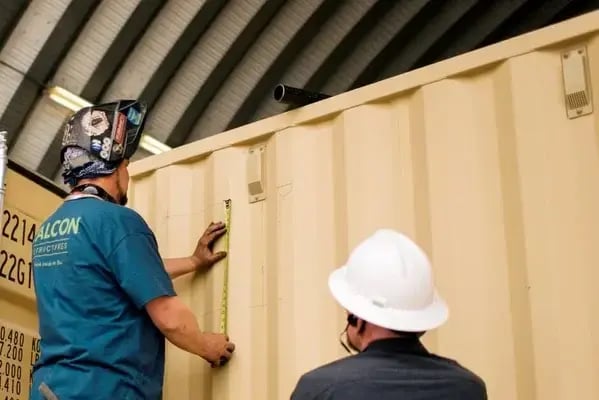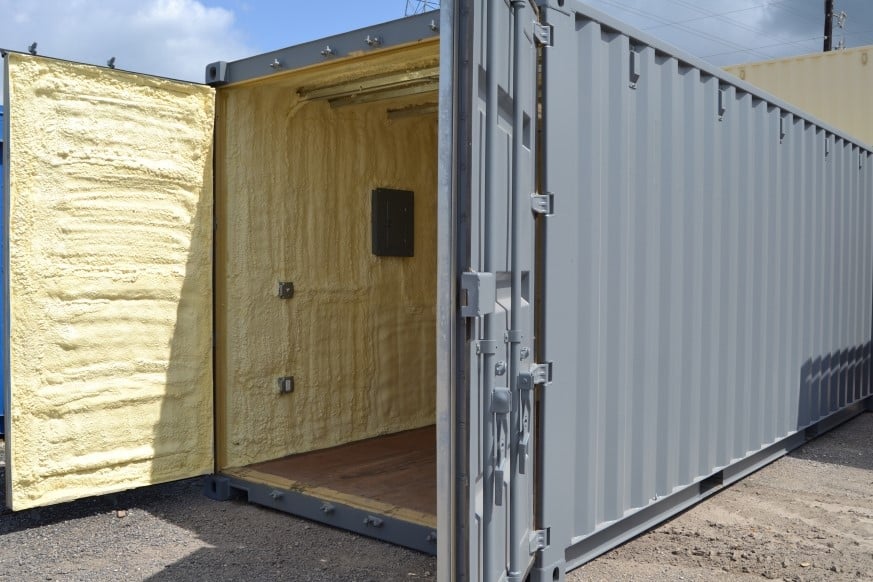Shipping Container Ventilation: What You Need To Know for Your Project
 Becca Hubert | Jul 24, 2024
Becca Hubert | Jul 24, 2024

A crucial factor in transforming a shipping container into a usable, habitable space is ventilation. While all containers come with small vents that help circulate air in the box while it’s transported on cargo ships, these aren’t very effective at regulating the conditions inside a modified container.
Deciding what kind of shipping container ventilation you need starts with knowing how you intend to use your container and what modification options are available to you. These modifications include other important temperature control measures that improve ventilation efficiency, like insulation and climate control. Here are a few shipping container vent solutions broken down by common use cases.
Ventilation & Climate Control for Sensitive Material Container Storage
Many companies turn to modified containers as secure, portable storage for their sensitive materials. Take data centers, for example. These facilities house industrial computer systems and other mechanical components, which are extremely sensitive to overheating. Such structures must be outfitted with sophisticated ventilation and climate control in order to protect the valuable equipment and prevent any malfunctions. Here are a few modifications you can expect to see on a project like this.
Spray foam insulation - The superior R-value of spray foam provides excellent thermal resistance, which helps maintain stable temperatures for servers and other electrical equipment.
Climate control - Depending on the size and purpose of your container, you might need a PTAC or two-ton industrial air conditioner to keep the interior at a reliably cool temperature.
Electrical hookup - While a container like this would be connected to power already, we’ve had customers use it to incorporate other ventilation control measures, like a dehumidifier for rare books and manuscripts.

Ventilation & Climate Control for Container Workspace
Before we begin modifying a workspace floor plan for a customer, we always ask for more information about how and where the container will be used. This often influences our recommendations for climate control and ventilation.
Active vents – Active vents are mechanical and use electric power to pull air out of the room and expel it outside, helping eliminate stale air, humidity, and odor. These are not standard on our workspace floor plans, but we do recommend them for special circumstances. For example, we recently shipped a double-wide workspace to Hawaii, and we added active vents to help control the moisture levels in such a tropical climate. Other reasons to include active vents in your container workspace are dusty environments or job sites with hazardous materials.
Insulation - Batt or spray foam insulation are common choices for container workspaces. We might recommend multiple layers of spray foam insulation on all six sides if the container will be used in an extreme climate.
PTAC - Our workspace floor plans include a wall-mounted PTAC unit to keep the interior as comfortable as a stick-built structure. Depending on the location, some customers opt for a second PTAC or a two-ton heavy duty HVAC.

Ventilation & Climate Control for Container Bathrooms
If you’re considering a shipping container bathroom, it’ll require extra ventilation components, just like the bathroom of a traditionally built structure.
Active vents - These vents are like the ones you turn on in your bathroom at home. Depending on the size of your bathroom container, you might need multiple active vents.
Passive vents - If your container includes a shower, we might recommend adding a passive vent near it. While not as strong as an electric-powered active vent, passive ones still help heat and moisture escape while improving the air quality.
Plumbing vent - A plumbing vent extends from the plumbing system up through the roof of the container. It regulates air pressure, prevents ingress of sewer gases, and facilitates effective drainage.
Insulation and climate control - Like other container structures, the insulation and climate control you choose will affect the interior environment. For bathrooms and locker rooms, we often go with spray foam insulation and a standard PTAC. If it’s an industrial application, like a 10-shower locker room, we might recommend two-ton HVACs.

Ventilation for Mechanical Testing Container Storage
Modified shipping containers are ideal for engine or battery testing because they’re durable, enclosed, and can be relocated to safe distances from people and other structures. While every application is unique, here are some of our common ventilation and climate control suggestions for such projects.
Exhaust fan - These fans can be up to three-feet wide and are meant for industrial applications. The motor on them pushes out fumes, heat, and moisture. Generating air flow like this is a must, especially if workers are present inside the container while potentially hazardous fumes are being released.
Spray foam insulation - We recommend spray foam insulation for industrial testing containers for several reasons. First, its higher R-value and moisture barrier make it easier to control the interior conditions of the container. But it’s also more fire-resistant than other insulation options, which is a valuable feature for something like an engine testing room.
Shipping container ventilation, when thoughtfully designed with climate control measures in mind, can be an important factor in determining how well your container will serve your project purpose.
Whether your modified shipping container project looks like one of the examples above or is a unique use case, our experienced team can guide you to the right design. Contact us to get started at Sales@FalconStructures.com or 512-231-1010.
SUBSCRIBE
- Shipping Container Modifications
- How-Tos
- Workspace
- Commercial Construction
- Multi-Container Buildings
- Storage Solutions
- Industrial Enclosures
- Bathrooms & Locker Rooms
- Oil & Gas
- Climate Control
- Green Building
- Living Space
- Industry Insight
- Military & Training Facilities
- Water Treatment Solutions
- Energy
THINK INSIDE THE BOX®
WITH OUR BLOG
Get everything from shipping container basics, to detailed how-tos and industry news in our weekly blog. Stay inspired and subscribe!
RELATED BLOGS

What You Need to Know About Insulated Conex Containers
Marissa Morin | May 10, 2023 | 4 min read
READ MORE
Shipping Container Insurance: How to Protect Your Jobsite Office
Marissa Morin | May 17, 2023 | 3 min read
READ MORE

Safety in Construction: Ensuring Your Team is Well Equipped
Marissa Morin | Apr 27, 2022 | 3 min read
READ MORE




